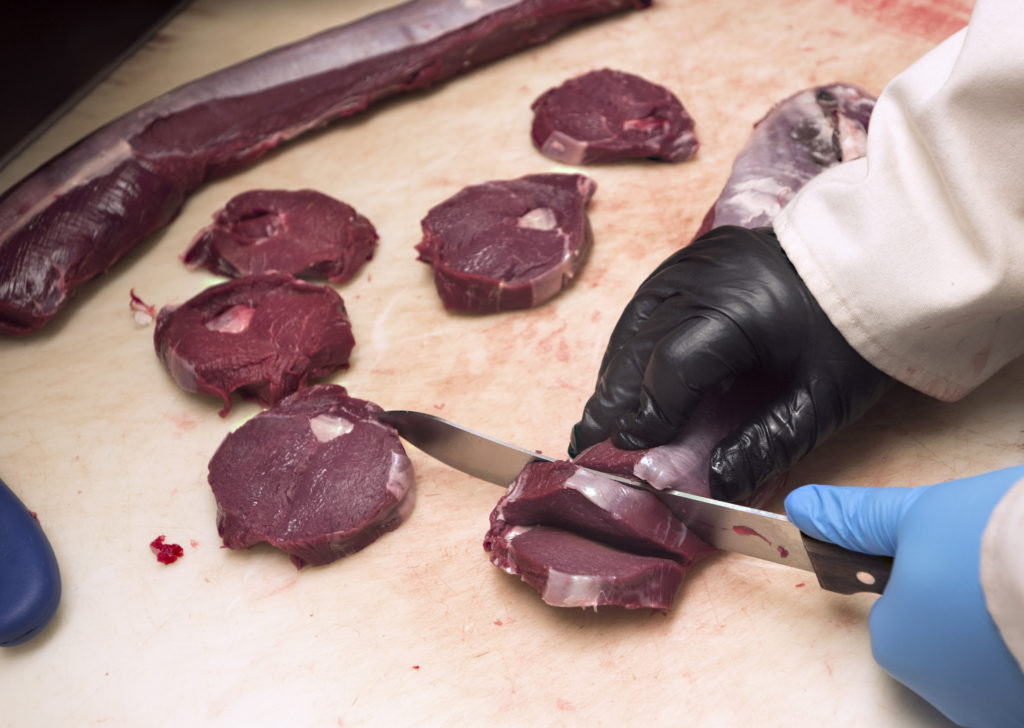How to cook venison

Deer meat has gotten a bad reputation for being a tough, chewy, gamey meat that’s difficult to work with and not worth the effort. But with attention and proper handling, venison can be a delicious, healthy alternative to beef.
Wild vs. Farm Raised
Venison is a dark red lean meat with little fat. It has more protein, iron and Vitamin B6 than beef, with one-third the fat content.
“Farm raised deer are milder in flavor, those are the ones sold in stores,” said Leon Emery, owner of Emery’s Meat and Produce in Brewer, Maine.
“Gamey is a weird concept. In general, gamey is an aroma and not a flavor, and a result of poor handling. Most meat you buy in stores is corn fed, which creates a similar taste profile. With a different diet, it’ll taste different. If you’ve had lean grass fed beef, venison tastes similar,” said Hank Shaw, food writer, author of Hunter, Angler, Gardener, Cook and “Buck, Buck, Moose: Recipes and Techniques for Cooking Deer, Elk, Moose, Antelope and Other Antlered Things.”
Types of Cuts
Venison has two types of cuts: tender and working. Tender cuts were areas that didn’t get much use during the deer’s life, so they have a minimal amount of connective tissue.
Tender cut areas are mostly in the back and some parts of the leg muscles, when properly butchered and trimmed. Backstraps, long strips of meat from both sides of the spine, are a popular and versatile tender cut.
Tender cuts are better prepared with quick cooking methods, up to rare or medium rare. The worst thing you can do is overcook venison; it makes the meat rubbery, chewy and dry.
Cooking Venison
“White tailed deer or wild game deer, you can treat a lot like beef. Cooking it rare is okay,” Emery said. “Loin steak is the easiest, just some salt, pepper and butter.”
Working cuts come from areas with heavily used muscles and have a lot of connective tissue and therefore more flavor than tender cuts. They’re found mostly in the shoulder, rib and leg areas.
“I’m more excited to cook the front of the deer: shanks, shoulder and neck. Backstrap is just a steak; nice, but it’s one note. You can do all kinds of things with shank. I like to turn an unloved part into the best part of the deer,” Shaw said.
Working cuts should be cooked for a long time, at a low temperature to break down the connective tissues.
“Wild venison can taste very gamey in stews; adding a lot of spices can help cover the taste. Rosemary helps a lot with masking the gamey flavor,” Emery said.
“Connective tissue becomes your friend when you braise or stew. A nice simmer results in a silky venison because the connective tissue melts,” Shaw said.
If you don’t want to slow cook a tough cut, you can grind the meat up. Ground venison lends itself to delicious burgers, meatloaf, sausages and meatballs. You can add ground pork for some additional fat content without losing the unique venison flavor.
“Ground venison when it’s with pork fat, or beef fat, is better. Ground venison is tricky to work with alone, because it has no fat. I like using pork fat because it has a neutral flavor with a lower melting point,” Shaw said.
According to Shaw, the easiest cuts to work with for beginners are shoulders, stew meat or chunks. “It will only need time. Cook it more if it’s not tender enough for you,” said Shaw.
“Most beginners tend to cook the tender parts too much and the tough parts too little. Don’t get hung up about it. Cooking venison is a learning process. It takes practice, but it’s not rocket science. Have fun in the kitchen,” Shaw said.
Where to get venison
So, where can you get venison to cook?
According to the United States Department of Agriculture Food Safety and Inspection Service, most states allow the hunting of wild game for personal consumption but not to sell. Wild game can — where allowed — be gifted by the hunter who shot it, but the meat has to be packaged and (in Maine) labelled correctly, with the hunter’s permit number clearly marked, so the meat is easily traceable, Emery said.
That doesn’t mean you won’t find venison in stores though. Farm-raised game, such as deer, can be sold.
“Farm raised deer, usually New Zealand Red Deer, is what’s sold in stores. It tends to be milder in flavor than wild game,” Emery said.
